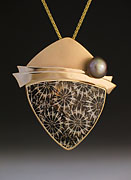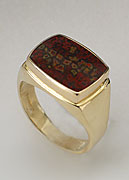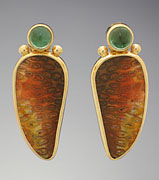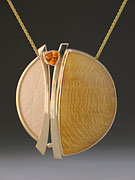|
|
|
|
Agate
|
|
|
| Curved bands of
color formed by rhythmic crystallization of quartz within volcanic
rocks are the distinguishing characteristic of agates. The ancient
Egyptians believed that agates protected the wearer from lightning,
bestowed the power of oratory, and quenched thirst. Among the
distinctive varieties used by Murphy Design are spotted and striped
agates, delicate "blue lace" agates, and "moss agates," which are
actually a closely related quartz named for their mosslike (not banded,
and therefore technically not agate) patterns. Protect all gemstones
from scratches, blows, and extremes of heat and cold. |
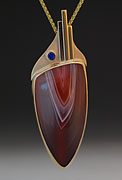 |
|
|
|
Amethyst
|
|
|
| Amethyst, the
most highly valued member of the quartz family, ranges in color from a
delicate violet to a deep, royal purple. Amethysts abound in ancient
Greek and Egyptian ornaments and in the British crown jewels. The
ancient Greeks believed that wearing an amethyst or drinking from an
amethyst chalice would prevent intoxication. Amethyst was also
associated in ancient times with protection, peace, tranquility, piety,
spiritual wisdom, humility, sincerity, and contentment. Amethyst is a
tough stone that you can wear every day with little fear of harming it.
|
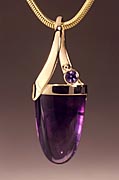 |
|
|
|
Aquamarine
|
|
|
| Aquamarine--Latin
for "water of the sea"--is rich in ancient lore. It was said to possess
the calming effects of the sea, to aid those who travel by water, to
help establish happy marriages, to protect newborn babies, to bestow
insight and foresight, and to induce sleep. The aquamarine is a
universal symbol of youth, hope, and health. A 243-pound aquamarine
crystal, blue on the inside and green on the outside, was found in
Brazil in 1920; the American Museum of Natural History in New York City
has a 13-pound piece of the green outside portion. Another famous
Brazilian aquamarine was given to American First Lady Eleanor Roosevelt
by the Brazilian government and is now in the Hyde Park Museum in New
York City. |
 |
|
|
|
Azurite-Malachite
|
|
|
| Azurite, named
for its azure blue color, often occurs with malachite in or near copper
deposits. Malachite is a rich green stone that was mined as early as
4000 B.C. by the ancient Egyptians, who attached it to children's
cradles to drive away evil spirits. The Egyptians, Greeks, and Romans
used it in jewelry and, in powdered form, as eye shadow. Much later,
the Russian czars used malachite from the Ural Mountains as wall
paneling and inlay to decorate their palaces. It symbolizes eternal
spring and is said to protect its owner from lightning. Malachite's
bands and whorls embedded in deep blue azurite create a miniature
landscape of great beauty. Protect it from blows, scratches, household
chemicals, and extremes of heat and cold--and don't use an ultrasonic
cleaner. |
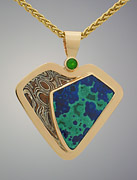 |
|
|
| Carnelian |
|
|
| Carnelian is a
red-orange member of the quartz family. It is known to virtually all
ancient cultures in the West, Asia, Middle East, and pre-Columbian
America. Carnelian has a prominent place in the jewelry and other
treasures fond in King tutankhamen's tomb. Many fine carnelian ring
stones carved by ancient Romans also have survived. A stone rich in
legend, carnelian was said to strengthen creativity, prosperity,
ambition, and curiosity; balance body energies; soften anger; and
promote focusing on and achieving goals. |
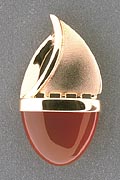 |
|
|
|
Chalcedony
|
|
|
| Chalcedony is
both a general term for translucent quartzes and specifically the name
of a bluish gray quartz. In ancient times chalcedony was used for
cameos and as a talisman against idiocy and depression. The name is
derived from Chalcedon, an ancient seaport in Asia Minor near
Byzantium, a probable early source of chalcedony. Pliny records that
partially transparent chalcedony was used for observing eclipses of the
sun. Among the other, structurally similar, quartzes described by the
general term chalcedony are agate, chrysoprase, jasper, and chrysocolla
quartz. |
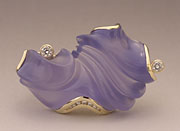 |
|
|
|
Chrysocolla Quartz
|
|
|
| Chrysocolla,
which is very rare, takes its intense color from its copper content (as
turquoise also does). In modern lore, chrysocolla is sometimes called
gem silica and is said to have a calming effect and therefore to be
beneficial to those who suffer from emotional stress. Alone,
chrysocolla is quite soft, but when it is mixed with quartz it becomes
considerably more durable. Protect chrysocolla (and all gemstones) from
scratches, blows, household chemicals, and extremes of heat and cold. |
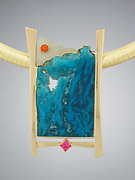 |
|
|
|
Chrysoprase
|
|
|
| Chrysoprase
(from the Greek meaning "golden green") is a quartz once associated
with mines in Poland; it was used to decorate a chapel in
Czechoslovakia and a castle in Germany. Legend has it that Alexander
the Great wore a chrysoprase during all of his battles until, after his
Indian campaign, he took it off to bathe in the Euphrates River and a
serpent dropped it in the river. Chrysoprase traditionally symbolizes
happiness, enterprise, and prudence; in modern lore it is said to
balance physical, mental, and emotional well-being. Much of the world's
chrysoprase now comes from Australia and from Arizona, California, and
Oregon in the United States. |
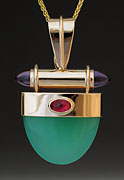 |
|
|
|
Citrine
|
|
|
| Citrine, a
member of the quartz family of gemstones, ranges in color from sunny
yellows to a tawny golden brown. Its name is derived from the French
word for lemon: citron. People once carried citrine to protect them
from the plague, evil thoughts, and snake bites. In modern lore, it is
said to expand consciousness and promote mental clarity. Found mainly
in Brazil, citrine is a durable stone that holds up well to being worn
every day. |
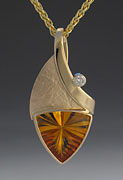 |
|
|
| Diamond |
|
|
| Diamond, the
hardest gemstone, is carbon formed 50 miles or more within the earth at
high temperatures and under great pressure. Its name comes from the
Greek adamas, unconquerable. India was the world's
first source of diamonds, which were introduced to the western world
when a traveling Frenchman brought a diamond back to France in 1605.
Many of the world's diamonds now come from mines in Siberia, Africa,
and Australia. An enterprising Texan once "mined" diamonds from the
ocean bottom with the equivalent of a huge vacuum cleaner. |
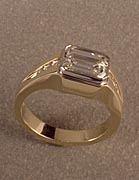 |
|
|
|
Drusy Quartz
|
|
|
| Drusy quartz is
found lining the pockets inside geodes. Its rough surface of tiny
reflecting crystals takes on the color of the materials it forms on:
chrysocolla (a bright blue), rhodochrosite (rosy red), psilomelane
(black), blue lace agate (a delicate blue), and fossilized coral are a
few. Protect drusy--and all gemstones--from scratches, blows, and
extremes of heat and cold. |
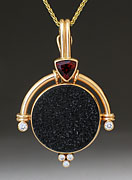 |
|
|
|
Emerald
|
|
|
| Emeralds have
long been associated with Colombia, where they were mined by the Incas;
some of the deposits found by the Incas are still being mined today.
Ancient legend has it that emeralds make the wearer more intelligent
and more honest, cure poor eyesight, and bestow the power to predict
the future. Tiny crystals trapped in emerald form what is known to
experts as a "garden" that can be seen only under magnification. |
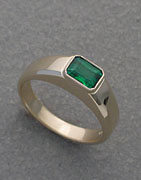 |









